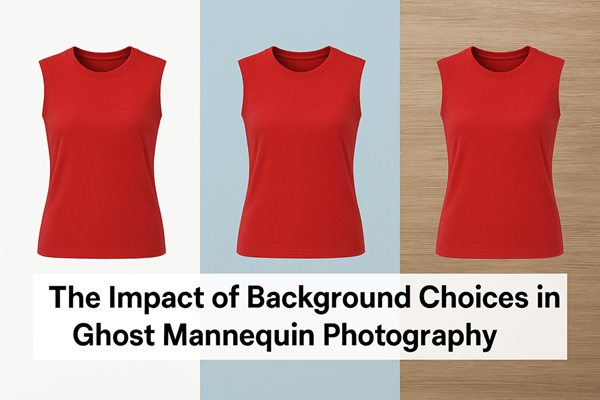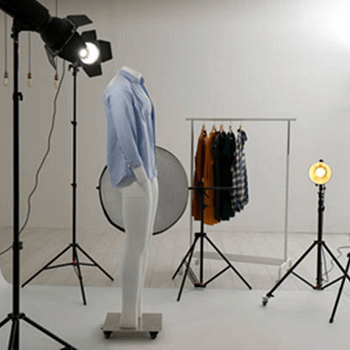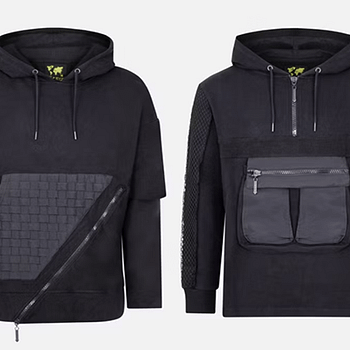The Impact of Background Choices in Ghost Mannequin Photography
Ghost mannequin photography, often referred to as the “invisible mannequin” technique, is a cornerstone of e-commerce product photography, particularly for clothing retailers. By creating the illusion of garments being worn without a visible mannequin, this method showcases the shape, fit, and details of clothing in a clean and professional manner. However, one critical yet often overlooked aspect of ghost mannequin photography is the choice of background. The background, whether white, coloured, or textured, plays a significant role in shaping the final look of the image and influencing customer perception. In this blog post, we’ll analyse how different background choices impact the aesthetic and commercial effectiveness of ghost mannequin photography.
The power of a white background
A white background is the go-to choice for most e-commerce platforms, and for good reason. Its simplicity ensures that the focus remains entirely on the garment, highlighting its colour, texture, and design without distraction. This clean, neutral backdrop aligns with the branding of major retailers like ASOS, Zara, or Amazon, where consistency and clarity are paramount.
Advantages:
- Maximises focus: A white background eliminates visual noise, allowing customers to concentrate on the clothing’s details, such as stitching, fabric texture, or embellishments.
- Versatility: White backgrounds are universally compatible with most online platforms, ensuring images meet marketplace guidelines (e.g., Amazon’s requirement for pure white backgrounds with RGB 255, 255, 255).
- Professional appeal: The minimalist aesthetic conveys a sense of professionalism and trustworthiness, which can enhance customer confidence in the brand.
Drawbacks:
- Lack of personality: While effective for functionality, white backgrounds can feel sterile and may fail to convey the brand’s unique identity or story.
- Competition clutter: With so many retailers using white backgrounds, it can be challenging to stand out in a crowded market.
Customer perception:
Customers associate white backgrounds with reliability and clarity, making them ideal for shoppers who prioritise product details over brand aesthetics. However, for brands targeting a niche or creative audience, a white background might seem too generic, potentially reducing emotional engagement.
The appeal of coloured backgrounds
Coloured backgrounds introduce a dynamic element to ghost mannequin photography, offering an opportunity to align images with a brand’s identity or seasonal trends. For example, a soft pastel background might evoke springtime freshness, while a bold red could signal festive energy.
Advantages:
- Brand differentiation: A carefully chosen colour can set a brand apart, making its product images instantly recognisable. For instance, a luxury brand might opt for a deep navy or charcoal to exude sophistication.
- Emotional connection: Colours evoke emotions, blue conveys calm, yellow radiates optimism, which can influence how customers feel about the clothing and the brand.
- Seasonal flexibility: Coloured backgrounds can be tailored to reflect seasonal campaigns, such as warm earthy tones for autumn or vibrant hues for summer collections.
Drawbacks:
- Risk of distraction: A poorly chosen colour can overpower the garment, drawing attention away from the product itself.
- Platform limitations: Some e-commerce platforms may require white backgrounds for primary images, relegating coloured backgrounds to secondary or social media use.
- Colour clashing: The background colour must complement the garment to avoid visual discord, which requires careful planning.
Customer perception:
Coloured backgrounds resonate with customers who value creativity and brand personality. They can make a brand feel more approachable or luxurious, depending on the hue. However, if the colour overshadows the garment or clashes with it, customers may perceive the brand as unprofessional or inconsistent.
The charm of textured backgrounds
Textured backgrounds, such as wood, marble, or fabric, add depth and character to ghost mannequin photography. They are less common in e-commerce but are gaining popularity among boutique brands and those targeting premium or artisanal markets.
Advantages:
- Unique aesthetic: Textured backgrounds create a distinctive visual style, helping brands stand out in a sea of plain backgrounds.
- Storytelling potential: A rustic wooden background might suggest sustainability, while a marble backdrop could evoke luxury, allowing brands to tell a story through their imagery.
- Enhanced context: Textures can subtly mimic real-world environments, making the garment feel more relatable and wearable.
Drawbacks:
- Complexity in execution: Textured backgrounds require precise lighting to avoid unwanted shadows or reflections that could detract from the garment.
- Limited versatility: Unlike white backgrounds, textured backgrounds may not suit all products or platforms, limiting their use to specific campaigns.
- Editing challenges: Ensuring the texture complements rather than competes with the garment can be tricky during post-production.
Customer perception:
Textured backgrounds appeal to customers who value authenticity and craftsmanship. They can make a brand feel premium or bespoke, fostering a sense of exclusivity. However, if the texture is too bold or poorly executed, it may confuse or alienate customers who prefer straightforward product images.
Choosing the right background for your brand
The choice of background in ghost mannequin photography depends on several factors, including your target audience, brand identity, and the platforms where your images will appear. Here are some practical tips to guide your decision:
- Know your audience: If your customers prioritise clarity and ease of comparison (e.g., on Amazon or eBay), a white background is likely the best choice. For a younger, trend-driven audience (e.g., on Instagram), experiment with coloured or textured backgrounds to capture attention.
- Align with brand identity: Ensure the background reflects your brand’s values. A sustainable fashion brand might opt for natural textures, while a high-street retailer might stick to white for mass appeal.
- Test and iterate: Conduct A/B testing with different backgrounds to see which drives higher engagement or conversions. For example, compare click-through rates for white versus coloured backgrounds on social media ads.
- Balance consistency and creativity: Use white backgrounds for primary product images to meet platform requirements, but incorporate coloured or textured backgrounds for secondary images or marketing campaigns to add variety.
Conclusion
The background in ghost mannequin photography is far more than a mere backdrop, it’s a powerful tool that shapes the visual impact of your product images and influences how customers perceive your brand. White backgrounds offer clarity and professionalism, coloured backgrounds inject personality and emotion, and textured backgrounds provide uniqueness and storytelling potential. By carefully selecting a background that aligns with your brand and audience, you can elevate your ghost mannequin photography, enhance customer engagement, and ultimately drive sales. Whether you’re a small boutique or a large retailer, experimenting with background choices can transform your product photography into a compelling visual experience. So, next time you set up your ghost mannequin shoot, consider the background not just as a setting, but as a strategic element in your brand’s story.




